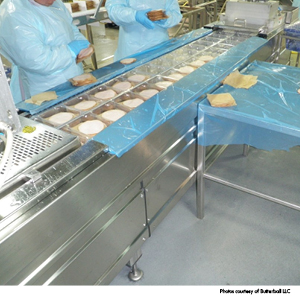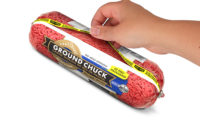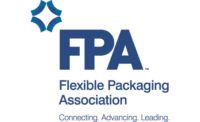A number of different packaging options are available depending on the type of product, texture, shelf life, appearance, cost and other contributing factors. For fresh deli product, Butterball LLC and numerous other poultry and deli-meat producers utilize vacuum-packaging technology to maximize shelf life and provide safe, quality product at an affordable price.
Implications for freshness, quality and safety

|
Vacuum packaging offers a number of benefits to deli producers. Extracting oxygen inhibits the reproduction of oxygen-dependent micro-organisms and reduces the oxidation processes, thus increasing food safety. The vacuum-packed product displays improved texture and appearance, ensuring its quality and freshness for much longer.
From a production standpoint, vacuum packaging also offers an efficient, cost-effective and safe solution when compared to other packaging methods. With only two employees needed to operate most vacuum-packaging equipment, the technology enables producers to streamline packaging and minimize workforce needs. The equipment is safe to use with minimal hazard potential, helping producers protect the health and safety of associates.
Deli-style vacuum packaging equipment options
Butterball utilizes a Cryovac® 8600 Series Rotary Vacuum Chamber System to package the majority of its product. Cryovac 8600 is a universal, high-speed vacuum-chamber machine used for packaging fresh and processed meat and cheese products that features speeds from 50 to 60 cycles per minute with the capability to handle bag widths up to 14 inches.
In the system, a loaf of processed meat is conveyed to a bagger machine and then continues down the conveyer to the packaging machine, where it is transported into one of the eight vacuum chambers.
The product goes on to a platen then into a stainless-steel or aluminum chamber where the air is evacuated by vacuum pumps. Heat-seal bars at various temperatures come together on top and bottom of bag to heat-seal the package, while the vacuum simultaneously evacuates all air out. Once vacuumed and heat-sealed, the chamber opens to disperse the packaged product into a hot water bath at 185 degrees Fahrenheit to both shrink the material to the size of the product and give it a sleek, glossy appearance.
Cook-in-bag options
For raw material, Butterball utilizes the Cryovac 8490 Vertical Rotary Vacuum Chamber System’s cook-in-bag application. This system works at speeds from 10 to 20 cycles per minute depending on product weight, consistency and temperature, with the capability to handle bag widths up to 12 inches.
The equipment automatically positions and fills each bag from the bottom up, then advances it to the rotating chambers for vacuuming and sealing the package. The addition of a product pump, volume portioner and shrink tunnel complete the cook-in-the-bag system. Pump, portioner and spout valve fill the bag with a pre-selected volume with various seal configurations available to provide preferred package shape.
Cook-in-bag applications offer one of the safest forms of packaging for deli meat because products are never exposed to the outside atmosphere after cooking, eliminating the potential for bacterial growth. Deli loaf items, such as whole muscles, emulsion and chunks of meat are best for this process.
Roll stock machines
Another type of vacuum-packaging equipment available to deli producers is a form-fill-seal, or roll stock machine. This machine utilizes two sheets of plastic, which are heated to form a pocket. Once the product is conveyed into the pocket, another sheet of plastic is used to close the package. The final package is sent to a heat-sealing and cutting system to trim edges.
For raw products, modified-atmosphere packaging is used to inject a carbon-dioxide gaseous mixture that helps preserve the freshness of the product by inhibiting the growth of bacteria. In modified-atmosphere packaging, producers incur the additional cost of the gaseous input, which is not necessary for most cooked products.
The roll stock machine can also be used for tray-packed items such as ground turkey, turkey filets, wings and legs. These products are placed onto preformed trays and the plastic is heat-sealed and vacuum-packaged.
Selecting the right technology
Appearance, type of product, shelf life, waste, costs of labor and materials, maintenance and operating costs, utility usage and package leakage rates all play a role in determining the best equipment option for each product.
The final look of a package is an important factor, and the equipment Butterball uses allows for a more aesthetically pleasing appearance by producing very little trim surrounding the package. Additionally, the hot water bath provides a sleek and glossy appearance.
Costs are another consideration for deli producers. While both the Cryovac 8600 and roll stock machine offer high efficiency and minimal labor requirements, costs differ in materials, waste and maintenance. Vacuum-packaging done through the Cryovac 8600 has no consumables, but the cost of materials is a bit more expensive than roll stock machine materials. However, the roll stock machine uses more film to prepare and warm up, whereas the Cryovac 8600 produces minimal waste. Roll stock is also a more expensive process from a maintenance and parts perspective.
Both systems require two employees to operate, but robots can be used in the bagging phase to offer automatic loading and can be purchased in conjunction with the machines to reduce labor costs.
Both the Cryovac 8600 and roll stock equipment offer easy open options for usability and function, while the roll stock equipment also offers re-sealable options.
Challenges
One potential issue with all forms of vacuum packaging is leakage. Products that are coated with substances such as honey maple or caramel flavorings can occasionally get between the seal and cause leaking. Similarly, products seasoned with sharp items such as pepper kernels may puncture the package and cause leaking. To help eliminate risk, each package should be carefully inspected for any signs of leakage, with poorly packed product sent back through the machine and reprocessed.
Inspections, maintenance and cleaning
Performing regular inspections and ultimately maintaining food safety is essential in the production of fresh deli-products and all consumables. Machinery, materials and products should be cleaned and inspected often to be sure they are in good sanitary condition and physical shape. A thorough preventive maintenance program needs to be developed for any packaging equipment to ensure equipment reliability and uptime to meet production requirements. Also a detailed daily sanitation program is required to insure the safety of the products packaged.
Sucking out



